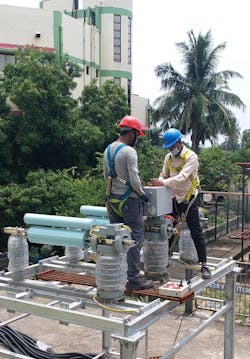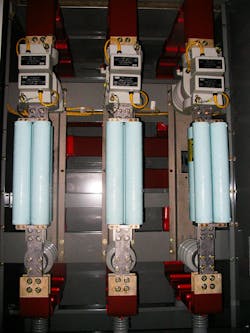Strategies to Mitigate Wildfire Risk
In today’s energy landscape, ensuring reliable and efficient power delivery while mitigating wildfire risks is a paramount concern for utilities. The increasing frequency and intensity of wildfires necessitate proactive measures to safeguard communities and protect infrastructure.
That is why utilities are moving to adopt distribution automation (DA) systems and upgrade equipment to include current-limiting protectors, improved reclosers and sensors. With support from suppliers, these changes enable utilities to better mitigate wildfire risks within their distribution systems.
Understanding Wildfire Risks
When it comes to power grids, wildfire risks run in both directions. Grid faults can spark wildfires, and wildfires threaten power grid equipment and personnel. Threats are classified as:
- Direct damage — Infrastructure damage from wildfires can include downed power lines, destroyed transformers, and compromised substations. This leads to widespread outages and potential ignition points for further fires.
- Indirect impacts — Smoke and ash from wildfires can disrupt critical communication systems and sensors within the grid. This disruption hinders situational awareness, hampers restoration efforts and increases health risks for field employees.
Equipment Upgrades
The following equipment upgrades can combine to enhance a utility’s wildfire mitigation efforts:
- Current limiting protectors (CLiP) combine the benefits of multiple over-current protective devices to deliver reliable and current-limiting electrical protection, helping keep workers and equipment safe from electrical hazards. These protectors mitigate wildfire risk by clearing faults in less than one-half of an electrical cycle. The fast-clearing time of these protectors can reduce arc-flash incident energy by 90%, relative to a five-cycle breaker and by 83%, relative to a three-cycle breaker. Common applications for current-limiting protectors include arc-flash energy reduction, power transformer protection, and protecting over-dutied equipment by limiting current.
- Protective devices like reclosers can coordinate easily with current-limiting protectors, as the protector is programmed to trigger at a customer-selected instantaneous current value. Reclosers minimize fault duration through faster trip times, which is particularly crucial in extensive overhead distribution systems. The reduced trip time has been proven to reduce the risk of wildfires. Certain reclosers can provide additional safety and reliability benefits. For example, a magnetic actuator system on some recloser models provides local and remote operation of the recloser on battery backup if the alternating-current source power is lost or interrupted. Furthermore, built-in wildlife protectors reduce the threat of wildlife-caused wildfires. A robust array of medium-voltage sensors provides real-time data and insights on voltage levels, power quality and fault identification. This improved monitoring enables utilities to make informed decisions, reduce downtime and improve overall performance. Furthermore, utilities can use this sensor data to assess equipment health and predict maintenance needs. Sensors also can be deployed to monitor weather conditions, such as wind speed and humidity, which can exacerbate wildfire risks.
Distribution Automation
Many utilities are adopting DA systems that offer benefits such as improved system reliability, enhanced crew safety and reduced outage durations — all of which mitigate wildfire risk.
DA involves the integration of intelligent devices, communication networks, and software applications to automate various tasks on the grid. It enables utilities to respond more quickly and more accurately to system events. If a fault occurs in a system with DA, then power can be restored to unaffected areas prior to a truck being sent for repairs.
Utilities seeking a reliable DA solution should evaluate single-phase fault location, isolation, and service restoration (FLISR) technologies. FLISR can automatically identify faults, isolate them from the rest of the system, and restore power to affected areas in minutes, seconds or even cycles, significantly reducing outage times.
Communication schemes are not required to implement FLISR, but they enhance automation capabilities by offering real-time insights for swifter and more sophisticated responses, especially with a larger number of devices. Alternatively, non-communicating loop schemes can be implemented such that reconfiguration decisions are based on voltages, currents and operations within the circuit (typically limited to 15 devices). Some automation platforms can handle both types of schemes.
Vendors can provide either script- or model-based automation options on single switches and multi-loop configurations. While script-based solutions rely on preprogrammed logic, model-based solutions leverage real-time data and system modeling for dynamic adaptability. The choice between the two hinges on the scale of the utility’s existing system, need for future scalability, and complexity of user-definable contingencies.
Working Together
G&W Electric offers a CLiP current limiting protector that works by detecting and reducing the voltage and current of downed power lines to prevent sparking. Then it sends a signal to the upstream G&W Electric Viper-ST recloser to open and clear all three phases. At the same time, current-limiting proectors can send a signal to its LaZer automation platform to compensate for the downed lines, reducing the risk of customer outages. All these functions are supported by the sensor-based real-time monitoring system.
Beyond Infrastructure Upgrades
Utilities that operate in regions with high wildfire danger should consider adopting additional risk mitigation efforts:
- Vegetation management — Regular vegetation management around power lines can play a crucial role in preventing wildfires.
- Community collaboration — Utilities can collaborate with fire departments, local authorities and surrounding communities to develop comprehensive wildfire mitigation plans and communication strategies.
- Public awareness — Educating the public on wildfire risks and safe practices can help to prevent accidental ignitions.
Protecting Communities
By combining advanced equipment and technology, a modern DA system, and a comprehensive understanding of wildfire risks, utilities can enhance the safety, reliability, sustainability and resiliency of their power grids and protect the communities they serve — from wildfires and many other risks.
About the Author
Alex Cochran
Alex Cochran ([email protected]) joined G&W Electric as global product manager for overhead technologies in late 2023. She has over a decade of experience in marketing, marketing management, product management and engineering as well as working with medium-voltage switchgear, overhead apparatus and power transformers. Additionally, she is an active member of various standards committees, including the IEEE Switchgear committee, and currently serves as Chair of the IEEE Technology and Innovation subcommittee. Cochran has an MBA degree from the University of Central Florida and a BSEE degree from the University of Florida.
Kate M. Cummings
Kate M. Cummings manages distribution automation for switchgear at G&W Electric. She received a BSEE from the University of Illinois at Chicago and has more than 15 years of experience in the power industry at G&W Electric, Ohmite Manufacturing and Maplechase. Cummings is actively involved in several professional organizations, including IEEE, IEEE PES and NEMA. Along with being key in developing and implementing G&W Electric’s microgrid, she also helped to design the Trident-SR controls installed at Lambeau Field in Green Bay, Wisconsin.
Andrew Garcia
Andrew Garcia ([email protected]) started at G&W Electric in 2022 as the CLiP current limiting protection system analyst. One of his responsibilities is to assist customers in implementing CLiP in their electrical systems. He developed a predictive model for the CLiP current limiting system that he utilizes to determine the coordination of CLiP with the rest of an electrical system. His knowledge of power systems and technical facets of the CLiP enable him to provide invaluable aftermarket support. Garcia graduated with a BSEE degree from University of Illinois Urbana-Champaign. He is a participant in CIGRE.


